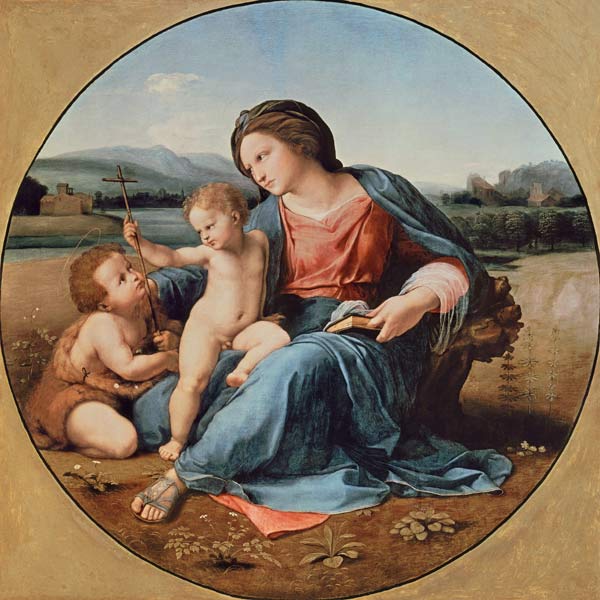May is Mary's Month and We Really Need Her Right Now!
As a single mother of two sons who was raised Catholic and received a format Catholic education (right up to a Master’s Degree of Theology Degree at Notre Dame), I have always loved Mary. Though my spiritual sensibilities have led me beyond the confines of Catholic teaching, I still have an affinity for her.
As an author of women’s historical fiction, now I am interested in learning what her life was really like, so after years of studying Virgin Mary symbolism in art and doctrine throughout the course of Christian history, this month I will present those that I find most interesting. This week I will focus on the way that Mary has been associated with nature.
Throughout the history of Christian art, Mary has been associated with the elements of Nature in such a way that in Christian deep consciousness, she has come to represent”Mother Nature.”
From the earliest Christian artworks in catacombs—Mary has been related with the heavens—almost always wrapped in a blue mantle, positioned before or suspended in the starry skies.
This depiction of Mary is from the second century, Catacomb of St. Pricilla in Rome. It is believed to be the oldest depiction of Mary extant. Mary is the main figure in the foreground, holding the infant Jesus, and an angel or prophet stands behind her pointing to the stars/or to Mary.

In Medieval Doctrine, Mary was proclaimed the Queen of Heaven like Juno and Hera and many of the ancient goddesses of this region before her.
In the height of the feudal political system Mariology became very “high,” which means that Mary rose to a sort of super-human stature. In the writings of the time she was hailed to be higher than the saints and angels. Accrodingly, she is depicted in art as a heavenly queen –- placed on thrones, and adorned with sun-shaped haloes and crowns made up of stars.
Like numerous ancient Mesopotamian and European Mother Goddesses, including Inanna of Sumeria, Astarte of Babylon and Phoenicia, Isis in Egypt and Greco-Roman empire, Mary also becomes associated with the moon and was proclaimed Star of the Sea.

Mary literally became the Woman of the Apocalypse in Revelation 12:1. From the earliest writings of the Church fathers—this verse tells of…”A great sign that appeared in the sky, a woman clothed with the sun, with the moon under her feet, and on her head a crown of twelve stars.”
The doctrine of the Immaculate Conception began to form in the Middle Ages (the belief that Mary was the only human born without the stain of sin, which gave her even more of a super-human status). From then on, Mary is consistently depicted in art with these heavenly attributes.
Looking at the painting, The Virgin of the Apocalypse with Saints and Angels, by Giovanni del Biondo in the High Middle Ages, we see a classic example of the high, heavenly Mary as the woman of the apocalypse. She wears a solar halo, her crown is made up of twelve stars, and a small crescent moon is positioned under her feet. Note also how much larger she is in scale –and how much higher in the picture she is positioned than the saints and angels that accompany her, as well as the skeleton under the floor of where she stands—these things convey that she is larger than life even of the other sacred beings, and that she “stands over” or conquers death.
Though the doctrine of the immaculate conception was developing in the 8th century, it wasn’t made official dogma of the church until the middle of the 19th century.
This coincides with the Baroque period in art, and in typical dramatic baroque fashion, Mary really takes of for the heavens – In these works of art, including this painting entitled The Immaculate Conception by Diego Velasquez, we find her suspended in cosmic space, hovering between the earth and the heavens, and always with a crown of 12 stars, surrounded by an areole of the sun, and standing on the moon,


Mary is also often depicted near water.
In the many paintings of Mary within pastoral or garden settings, there is often a gentle river or stream, spring or fountain — running through the landscape behind her.
Again, water—the sea with it tides assoc. with moon’s monthly phases and flow, the spring as a source of the flow of water and of life are pervasive symbols associated with the ancient goddesses, as well as Miriam from the Hebrew Bible, who Mary was probably named after. Throughout the Exodus Miriam is found by water and her actions within the context of the Exodus story show that the writers of this book associated her with water as a symbol of giving birth.
With the Reformation during the European Renaissance –Reformers questioned Catholic practices they considered to be excessive including iconography and what they referred to as “Mariolatry.”
In other words, though the Church Fathers were firm about the fact that Mary was not “divine” and should not be adored in the same way the Father, Son, and Holy Spirit were, she seemed to be soaring to goddess status in art and doctrine.
Catholicism upheld its devotion to the Virgin and to sacred art, but Mary was noticeably “demoted” in Christian art.
Mary’s humanity is stressed (as is Jesus’ in pietas, etc.), and her role as the model of humility.








